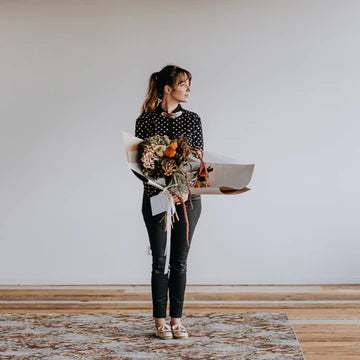DIY Dried Flower Arrangement
The great benefit of doing-it-yourself is you can choose some of your favourite flowers and foliage to give you a look that is all your own, or to fit within a particular colour palette. Perfect. Now… how do you it?
Read on friend...
what you’ll need:
Snips
Chicken wire
Floral Tape
step 1: gathering the goods
___
First, you’re going to want to go and find a bunch (actually, a few bunches) of different foliage and flower types. Rosie breaks these down into three main groups:
- Large leafy stems
- A few focal flowers
- A selection of delicate flowers
If you can’t find a good local floral supplier, Rosie suggests having a go at foraging. Raid your neighbour’s garden (but maybe ask first!), or a nearby park. It’s nice to get a big cluster of each type, aiming for 3-4 types per group for a large arrangement.
what leaves work best?
“Any bunches or stems of medium to large sized leaves that dry nicely and retain their shape well – things like camellia, eucalyptus, wattle or magnolia (which has lovely hints of rust on the underside of the leaf). Make sure you look for woody stems – the sturdier the stem, the easier it will be to incorporate into your structure,” says Rosie.
what flowers should we look for?
“Proteas make great focal flowers because they’re big, textural and make a real statement. All flowers are going to lose a lot of their colour through the drying process, so look instead for shapes and textures you like. For a bit of whimsy, that’s where your more delicate flowers come in. Any ‘spray’ flowers will work well (like the spray roses used here), maple seed pods, or dangle berries.”

step 2: the drying process
___
Once you’re happy with your lot, you’re going to hang your gathered goods in bunches some place nice and dry – like an airing cupboard. Using some twine, unflavoured dental floss or even stripped flax leaves, tie your bunches at their ends, then hang them upside down (flowers facing the floor) from a rack or clothes hanger your warm, dry spot.
Then… wait! Rosie says you’ll want to leave your bunches for a good two to three weeks until they’re completely dry before starting your arrangement.
step 3: get arranging!
___
Onto the fun part…
Mould your chicken wire into a ball shape with your hands and place it into your vase, filling the space inside. Use some floral tape to hold it in place.
Then, start adding your large leafy greens to your vase, using these to establish the shape of your arrangement. You might need to use your snips here to trim any twigs and branches at the bottom end of your stems.
Next, add your focal flowers to the centre/front of your arrangement. These look best in odd quantities ie. one, three or five.
Lastly, finish with your small, delicate flowers to give your arrangement whimsy and movement.

Play around with the placement and shape until you achieve the look you want. It doesn’t have to be perfectly symmetrical – wild is good! We love the more imperfect, asymmetrical style that’s popular right now.






Leave a comment